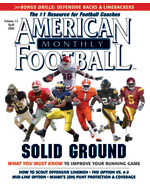AMERICAN FOOTBALL MONTHLY THE #1 RESOURCE FOR FOOTBALL COACHES
Article CategoriesAFM Magazine
|
Impact StatsThe Most Important Stat?by: AFM Editorial Staff © More from this issue What do all of the following colleges have in common after the end of the 2005 season? 1. Ohio State (Division I-A) 2. Duquesne (Division I-AA) 3. Edinboro (Division II) 4. Trinity (CT) (Division III) 5. Missouri Valley College (NAIA) 6. Vermilion CC (JC) All were the leaders in overall Rushing Defense in each of their respective divisions. “I believe Rushing Defense is the most important of all the statistics,” says Edinboro Defensive Coordinator Wayne Bradford, whose team led the nation among D-II colleges in that category, “It’s the number one priority because it dictates everything else. If we stop a first and ten to become second and eight it changes the mindset of your opponent. You could have four great players in the secondary but we can’t force our opponent to throw the ball. They do need to be involved in the run on the perimeter but it’s our up-front guys that make the difference,” Chuck Priore concurs. The former head coach at Trinity College (CT) whose team led all D-III schools in rushing, scoring, and total defense now heads up the D I-AA program at Stony Brook. “Your two priorities are a strong rushing defense and a strong running offense. With your defense, if you force your opponent to be one dimensional, you’ve increased your chances for success.” Cornell finished second in the nation in Rushing Defense among D I-AA colleges. “The quickest way to make a difference in you team is a strong rushing defense,” says Big Red head coach Jim Knowles. “To show an element of toughness and that you’re not going to be pushed around is important. Even if your offense is ineffective, they always know they’ll get the ball if you have a strong rushing defense.” Recruiting the right players for your rushing defense presents interesting challenges. “For our defense, we have two priorities,” says Stony Brook’s Priore: “1. Find recruits that are athletic and have the ability to get to the ball. Size is important but not as much as athleticism; 2. Make sure the defense – all 11 guys – know their role in the run game. Concentration is necessary so that players understand they don’t have to make every tackle or be a hero but know their job in pursuing the ball.” Edinboro recruits defensive players in a similar way. “We go relatively small but believe in recruiting speed and athleticism,” said Bradford. “We’ve had relatively small players be our conference Players of the Year. Seth Fragale, who won the award in 2004, was 6-2, 200 as a linebacker. “The game is so much faster today with spread formations, isolation plays, the shotgun and finesse offenses. We have to have the fastest, most athletic defense on the field. For example, we want our Inside Linebackers to be able to make a play on the sideline and also blanket the #2 wide receiver. As a team we only allowed 53 yards rushing a game in 2005. The worst thing for a defensive coach is feeling helpless if you believe you can’t stop the run. It’s a slow death. But our offense did a great job – averaging almost 200 yards on the ground per game and having the best time of possession (34 minutes per game) of any team in our conference.” “When we recruit a player, we look for attitude and tacklers,” says Cornell’s Knowles. “Is he getting through blocks and making plays. We feel you don’t have to be the strongest player but speed and athleticism and aggressiveness are all needed for an effective defense that has stunts and blitz packages.” Keith Turner, head coach at Vermilion Community College which led all junior colleges in rushing defense, has used the 3-5-3 defense to be effective. “We use the 4-4 at times but also the 3-5-3 because it puts more athletes on the field and we can do various forms of blitzing. We recruit the most athletic kids we can find.” In May, AFM concludes it’s 10-part series by breaking down each of the top ten statistical categories in building a championship team. The May subject: Scoring Defense. To view the original article on ‘10 Impact Stats to Build a Championship Team’ that appeared in the July issue of AFM, log onto AmericanFootballMonthly.com. |
|
| HOME |
MAGAZINE |
SUBSCRIBE | ONLINE COLUMNISTS | COACHING VIDEOS |
Copyright 2024, AmericanFootballMonthly.com
All Rights Reserved




